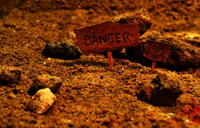 You’re not going to last very long in the construction business if you turn down any job with even the slightest hint of danger. In building contracts, your whole business is dealing with pneumatic drills and sledgehammers and table saws all day long, oftentimes three stories up in a building with no walls on it. The trick is being able to identify unmanageable, unnecessary danger, and knowing when to say no.
You’re not going to last very long in the construction business if you turn down any job with even the slightest hint of danger. In building contracts, your whole business is dealing with pneumatic drills and sledgehammers and table saws all day long, oftentimes three stories up in a building with no walls on it. The trick is being able to identify unmanageable, unnecessary danger, and knowing when to say no.
The source of danger doesn’t always come from the nature of the job itself. Roofing a two story home offers the risk of falling and spending the next couple months on worker’s comp, but that risk is relatively slim if you have the right tools, the right people, and the right timeline and budget to do the job safely. On the other, something as simple as building a doghouse can lead to serious injury if you’re trying to rush the job along for a client with unrealistic expectations.
The cornerstones of safety on a job site come down to the following:
- The time and budget to do the job safely. A client asking you to do a $2,000,000 job for $500,000 could well be the biggest contract a fledgling company has ever been offered, but it may well be the last one they’re ever offered if they wind up understaffed and under-equipped in order to stay within the budget.
- A crew with the requisite experience to handle the job without incident. Some tasks we learn on the job. Electrical wiring, welding and operating heavy machinery usually aren’t those. Don’t take a job if you don’t have, or can’t get, the people you’ll need to do the dangerous parts.
- A safe work environment. If you’re hired to install sunlights in a section of a shopping mall and the proprietors refuse to close that section off while you’re working there, an injury is effectively guaranteed. Construction is best conducted in an environment that the construction company is able to control.
- Proper insurance coverage. Adequate coverage doesn’t ensure that nobody’s going to get hurt, but it does ensure that you’ll be prepared should that happen.
If you don’t have these cornerstones in place, then it really doesn’t matter how well trained your people are in responding to an emergency, because they’re not going to be able to keep up with the emergencies that are taking place no a daily basis.






